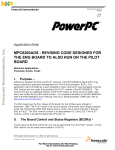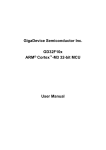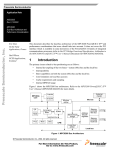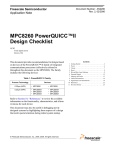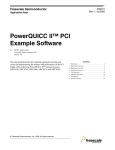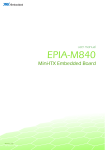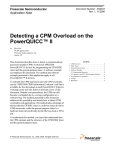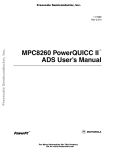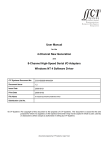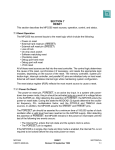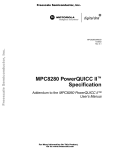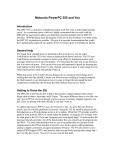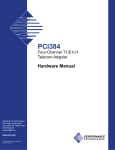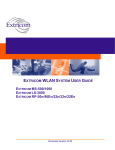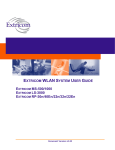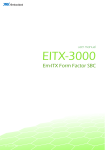Download AN2450: Intializing Flash Memory for the MPC8260ADS
Transcript
Freescale Semiconductor, Inc. Rev. 0, 02/2003 Freescale Semiconductor, Inc... Initializing Flash Memory for the MPC8260ADS The MPC8260ADS (Application Development System—ADS) can be initialized and configured with data from the programmable Board Control and Status Registers (BCSRx) located on the ADS board or the Hard Reset Configuration Word (HRCW) located in Flash. The initial configuration of the clock is determined at power-on reset from the values that are driven to the MODCK[1:3] pins at power-on reset. A DIP switch, located on the ADS board, is used to specify the values that are driven on the MODCK pins and to indicate that the Hard Reset Configuration Word is located in Flash. 1 References Table 1. References Document 2 Identification Number MPC8260 PowerQUICC II™ User’s Manual MPC8260UM/D MPC8260 PowerQUICC II™ User’s Manual Errata MPC8260UMAD/D MPC8260 PowerQUICC II™ Hardware Specifications MPC8260EC/D MPC8260ADS User’s Manual MPC8260ADS Clock Initialization Clock initialization takes place during the power-on reset event. Switch settings for DIP switch DS1[6-8] on the MPC8260ADS select input values for the MODCK[1:3] pins (see Table 2). The values placed on the MODCK pins can be controlled by placing the DIP switch in either the ON or OFF position. When configuring the initial clock configuration mode, placing the switch in the “ON” position forces a zero on the respective MODCK pin, while placing the switch in the “OFF” position forces a one. For example, if using a 66MHz crystal oscillator, placing DS1[6:8] OFF-ON-ON, will result in MODCK[1:3] values of 0b100 which will result in a 66MHz input clock and bus speed, a 133MHz CPM and a 166MHz Core. Additional clocking options can be achieved with the MODCK_H values set in the Hard Reset Configuration Word (see Table 3). © Freescale Semiconductor, Inc., 2004. All rights reserved. For More Information On This Product, Go to: www.freescale.com Freescale Semiconductor, Inc. Reset Initialization Freescale Semiconductor, Inc... Table 2. Clock Default Modes MODCK[1–3] Input Clock Frequency CPM Multiplication Factor CPM Frequency Core Multiplication Factor Core Frequency 000 33 MHz 3 100 MHz 4 133 MHz 001 33 MHz 3 100 MHz 5 166 MHz 010 33 MHz 4 133 MHz 4 133 MHz 011 33 MHz 4 133 MHz 5 166 MHz 100 66 MHz 2 133 MHz 2.5 166 MHz 101 66 MHz 2 133 MHz 3 200 MHz 110 66 MHz 2.5 166 MHz 2.5 166 MHz 111 66 MHz 2.5 166 MHz 3 200 MHz 3 Reset Initialization The MPC8260 can be initialized from reset in three ways. Two of the ways toggle the RSTCONF pin to latch the Hard Reset Configuration Word (HRCW) from the data bus, similar to the MPC8xx reset methodology, as described in the MPC860 PowerQUICC™ User’s Manual. The third and most common method uses the memory controller to access the area controlled by CS0, the global chip select, of the configuration master to fetch the HRCW from an EPROM (Flash). This method can be implemented on the ADS board by placing the DS1[1] DIP switch to the “ON” position. 4 Hard Reset Configuration Word from CS0 During the HRCW event from CS0, certain initialization processes will occur as documented in the MPC8260 PowerQUICC II™ User's Manual in Section 5.4.1 (HRCW). Because the port size of the initial transfers isn't known at boot time, only the first byte (D[0-7]) of each 32 bit access is used, since the smallest port size allowed is one byte. Four 32-bit accesses are required to fetch the entire HRCW. Although each access fetches 32 bits, only the most significant byte, bits 0-7, is used. The remaining 24 bits of each access are ignored. The accesses are made when the CS0 (global chip select) memory controller accesess the data at address 0x00 for the first byte of the HRCW, then address 0x08 for the second byte, and so on until the entire HRCW is fetched. Then, the 32-bit access HRCW is packed on the bus and presented to the MPC8260. 0 1 2 3 Field EARB EXMC CDIS EBM 4 5 BPS Reset 7 CIP ISPS 8 9 L2CPC 10 11 DPPC 12 — 13 15 ISB 0000_0000_0000_0000 16 Field BMS Reset 6 17 BBD 18 19 MMR 20 21 LBPC 22 23 APPC 24 25 26 CS10PC 27 — 0000_0000_0000_0000 Figure 1. Hard Reset Configuration Word Initializing Flash Memory for the MPC8260ADS For More Information On This Product, Go to: www.freescale.com 28 31 MODCK_H Freescale Semiconductor, Inc. Hard Reset Configuration Word from CS0 Freescale Semiconductor, Inc... Table 3. Hard Reset Configuration Word Field Descriptions Bits Name Description 0 EARB 1 External arbitration. Defines the initial value for ACR[EARB]. If EARB = 1, external arbitration is assumed. See Section 4.3.2.2, “60x Bus Arbiter Configuration Register (PPC_ACR).” 1 EXMC External MEMC. Defines the initial value of BR0[EMEMC]. If EXMC = 1, an external memory controller is assumed. See Section 10.3.1, “Base Registers (BRx).” 2 CDIS1 Core disable. Defines the initial value for the SIUMCR[CDIS]. 0 The core is active. See Section 4.3.2.6, “SIU Module Configuration Register (SIUMCR).” 1 The core is disabled. In this mode the MPC8260 functions as a slave. 3 EBM1 External bus mode. Defines the initial value of BCR[EBM]. See Section 4.3.2.1, “Bus Configuration Register (BCR).” 4–5 BPS Boot port size. Defines the initial value of BR0[PS], the port size for memory controller bank 0. 00 64-bit port size 01 8-bit port size 10 16-bit port size 11 32-bit port size See Section 10.3.1, “Base Registers (BRx).” 6 CIP1 Core initial prefix. Defines the initial value of MSR[IP]. Exception prefix. The setting of this bit specifies whether an exception vector offset is prepended with Fs or 0s. In the following description, nnnnn is the offset of the exception vector. 0 MSR[IP] = 1 (default). Exceptions are vectored to the physical address 0xFFFn_nnnn 1 MSR[IP] = 0 Exceptions are vectored to the physical address 0x000n_nnnn. 7 ISPS1 Internal space port size. Defines the initial value of BCR[ISPS]. Setting ISPS configures the MPC8260 to respond to accesses from a 32-bit external master to its internal space. See Section 4.3.2.1, “Bus Configuration Register (BCR).” 8–9 L2CPC1 L2 cache pins configuration. Defines the initial value of SIUMCR[L2CPC]. See Section 4.3.2.6, “SIU Module Configuration Register (SIUMCR).” 10–11 DPPC1 Data parity pin configuration. Defines the initial value of SIUMCR[DPPC]. For more details refer to Section 4.3.2.6, “SIU Module Configuration Register (SIUMCR).” 12 — 13–15 ISB Initial internal space base select. Defines the initial value of IMMR[0–14] and determines the base address of the internal memory space. 000 0x0000_0000 001 0x00F0_0000 010 0x0F00_0000 011 0x0FF0_0000 100 0xF000_0000 101 0xF0F0_0000 110 0xFF00_0000 111 0xFFF0_0000 See Section 4.3.2.7, “Internal Memory Map Register (IMMR).” 16 BMS Boot memory space. Defines the initial value for BR0[BA]. There are two possible boot memory regions: HIMEM and LOMEM. 0 0xFE00_0000—0xFFFF_FFFF 1 0x0000_0000—0x01FF_FFFF See Section 10.3.1, “Base Registers (BRx).” 17 BBD Bus busy disable. Defines the initial value of SIUMCR[BBD]. See Section 4.3.2.6, “SIU Module Configuration Register (SIUMCR).” Reserved, should be cleared. Initializing Flash Memory for the MPC8260ADS For More Information On This Product, Go to: www.freescale.com Freescale Semiconductor, Inc. Configuring Additional Processors Table 3. Hard Reset Configuration Word Field Descriptions (continued) Bits Name 18–19 MMR 20–21 LBPC1 Description Mask masters requests. Defines the initial value of SIUMCR[MMR]. See Section 4.3.2.6, “SIU Module Configuration Register (SIUMCR).” Local bus pin configuration. Defines the value of SIUMCR[LBPC]. See Section 4.3.2.6, “SIU Module Configuration Register (SIUMCR).” Freescale Semiconductor, Inc... 00 Local bus pins function as local bus 01 Local bus pins function as PCI bus (MPC8265, MPC8266, MPC8250 only). Reserved on all other devices. 10 Local bus pins function as core pins 11 Reserved 22–23 APPC1 24–25 CS10PC1 26–27 — Address parity pin configuration. Defines the initial value of SIUMCR[APPC]. See Section 4.3.2.6, “SIU Module Configuration Register (SIUMCR).” CS10 pin configuration. Defines the initial value of SIUMCR[CS10PC]. See Section 4.3.2.6, “SIU Module Configuration Register (SIUMCR).” Reserved, should be cleared. 28–31 MODCK_H High-order bits of the MODCK bus, which determine the clock reset configuration. See Chapter 9, “Clocks and Power Control,” for details. (If the device has PCI and is configured to PCI mode (PCI_MODE is driven low), this field has no effect and the value for MODCK_H is loaded directly from the MODCK_H pins. Note that the value of the MODCK_H bits are derived from the dedicated PCI_MODCK_H[0:3] pins when operating in PCI mode. ) 1 5 The user should exercise caution when changing this bit. This bit has an immediate effect on the external bus and may resultin unstable system operation. Configuring Additional Processors If additional devices are to be configured by this processor, then this process continues in a similar manner, with the addresses incrementing as before, until as many as 7 additional processors are configured. This is explained in further detail in the User's Manual in Section 5.4 (Reset Configuration) and Section 5.4.2.3 (Multiple 8260's with boot EPROM). The process requires the configuration slave devices to have their RSTCONF pins tied to the configuration master's address lines (A[0-6] for slave 1-7, respectively). Table 4. Configuration EPROM Addresses Configured Device Byte 0 Address Byte 1 Address Byte 2 Address Byte 3 Address Configuration master 0x00 0x08 0x10 0x18 First configuration slave 0x20 0x28 0x30 0x38 Second configuration slave 0x40 0x48 0x50 0x58 Third configuration slave 0x60 0x68 0x70 0x78 Fourth configuration slave 0x80 0x88 0x90 0x98 Fifth configuration slave 0xA0 0xA8 0xB0 0xB8 Sixth configuration slave 0xC0 0xC8 0xD0 0xD8 Seventh configuration slave 0xE0 0xE8 0xF0 0xF8 Initializing Flash Memory for the MPC8260ADS For More Information On This Product, Go to: www.freescale.com Freescale Semiconductor, Inc. Initialization Code 6 Initialization Code Freescale Semiconductor, Inc... We will use the initialization code titled INIT Example (works with ENG and PILOT revs of MPC8260ADS) under the heading Code Examples from the MPC8260 page of our website. This example sets up interrupt vectors, the hard reset configuration word, the memory controller for the ADS board (this can also be used as a guide for the memory controller setup for your target board) as well as general System Interface Unit parameters and a UART for demonstration purposes. The following is a list of the files contained in the ZIP: Init8260.s Initialization file Init8260.h Header file for init8260.s config.s Hard Reset Configuration Word 8260_int.s Exceptions vect_tbl.s Vector Exception Table Definitions uart.c Source file for UART character echo and LED flashing uart.h Header file for uart.c masks8260.h Standard masks for MPC8260 software mpc8260.h Internal memory map structure declarations for MPC8260 netcomm.h Global data type definitions init8260.map Included for informational purpose makefile MKS makefile init8260.out Downloadable ELF with symbol table file init8260.s3 S record file init8260.lnx Link command file These files contain all of the necessary components to compile an image that will boot and initialize the MPC8260ADS. Equipment capable of writing an image to a Flash memory module will be required. 7 MPC8260ADS Board In order to boot from Flash, rather than the Board Control and Status Registers, you must change DS1[1] to the ON position (marked Flash on the PCB). This will allow the processor to boot from the Hard Reset Configuration Word located in Flash Memory in address location of CS0. Depending on the type of Flash Module, the user may also be required to supply power to the Vpp connector P2. Refer to the Flash Manufacturer’s data sheet for information on the power requirements for Vpp. 8 Initialization of ADS Board Apply power and allow board to boot from Flash. The Serial Communication Controller (SCC1) will be configured from Flash to permit a 9600,1,0,n UART to the serial port, PA3, for echo demonstration of software. Also, a signaling LED will flash to indicate that the initialization was successful. Initializing Flash Memory for the MPC8260ADS For More Information On This Product, Go to: www.freescale.com Freescale Semiconductor, Inc. Flash Memory Map 9 Flash Memory Map The memory map is as follows: 0x0000 – 0x00FF Hard Reset Configuration Word 0x0100 – 0x0FFF Exception Vectors 0x1000 – 0xFFFF ADS Initialization Code 0x10000 – 0x01FFFFFF Demo Software (up to 32M Flash support) Freescale Semiconductor, Inc... 10 Summary By programming the Flash with a proven initialization sequence, the user can place their custom code in unused locations in Flash to test suitability with their operating system and the software interaction effects. Initializing Flash Memory for the MPC8260ADS For More Information On This Product, Go to: www.freescale.com Freescale Semiconductor, Inc. Freescale Semiconductor, Inc... Summary Initializing Flash Memory for the MPC8260ADS For More Information On This Product, Go to: www.freescale.com Freescale Semiconductor, Inc. How to Reach Us: Home Page: www.freescale.com Freescale Semiconductor, Inc... E-mail: [email protected] USA/Europe or Locations Not Listed: Freescale Semiconductor Technical Information Center, CH370 1300 N. Alma School Road Chandler, Arizona 85224 +1-800-521-6274 or +1-480-768-2130 [email protected] Europe, Middle East, and Africa: Freescale Halbleiter Deutschland GmbH Technical Information Center Schatzbogen 7 81829 Muenchen, Germany +44 1296 380 456 (English) +46 8 52200080 (English) +49 89 92103 559 (German) +33 1 69 35 48 48 (French) [email protected] Japan: Freescale Semiconductor Japan Ltd. Headquarters ARCO Tower 15F 1-8-1, Shimo-Meguro, Meguro-ku, Tokyo 153-0064 Japan 0120 191014 or +81 3 5437 9125 [email protected] Asia/Pacific: Freescale Semiconductor Hong Kong Ltd. Technical Information Center 2 Dai King Street Tai Po Industrial Estate Tai Po, N.T., Hong Kong +800 2666 8080 [email protected] For Literature Requests Only: Freescale Semiconductor Literature Distribution Center P.O. Box 5405 Denver, Colorado 80217 1-800-441-2447 or 303-675-2140 Fax: 303-675-2150 [email protected] Information in this document is provided solely to enable system and software implementers to use Freescale Semiconductor products. There are no express or implied copyright licenses granted hereunder to design or fabricate any integrated circuits or integrated circuits based on the information in this document. Freescale Semiconductor reserves the right to make changes without further notice to any products herein. Freescale Semiconductor makes no warranty, representation or guarantee regarding the suitability of its products for any particular purpose, nor does Freescale Semiconductor assume any liability arising out of the application or use of any product or circuit, and specifically disclaims any and all liability, including without limitation consequential or incidental damages. “Typical” parameters which may be provided in Freescale Semiconductor data sheets and/or specifications can and do vary in different applications and actual performance may vary over time. All operating parameters, including “Typicals” must be validated for each customer application by customer’s technical experts. Freescale Semiconductor does not convey any license under its patent rights nor the rights of others. Freescale Semiconductor products are not designed, intended, or authorized for use as components in systems intended for surgical implant into the body, or other applications intended to support or sustain life, or for any other application in which the failure of the Freescale Semiconductor product could create a situation where personal injury or death may occur. Should Buyer purchase or use Freescale Semiconductor products for any such unintended or unauthorized application, Buyer shall indemnify and hold Freescale Semiconductor and its officers, employees, subsidiaries, affiliates, and distributors harmless against all claims, costs, damages, and expenses, and reasonable attorney fees arising out of, directly or indirectly, any claim of personal injury or death associated with such unintended or unauthorized use, even if such claim alleges that Freescale Semiconductor was negligent regarding the design or manufacture of the part. AN2450/D For More Information On This Product, Go to: www.freescale.com








